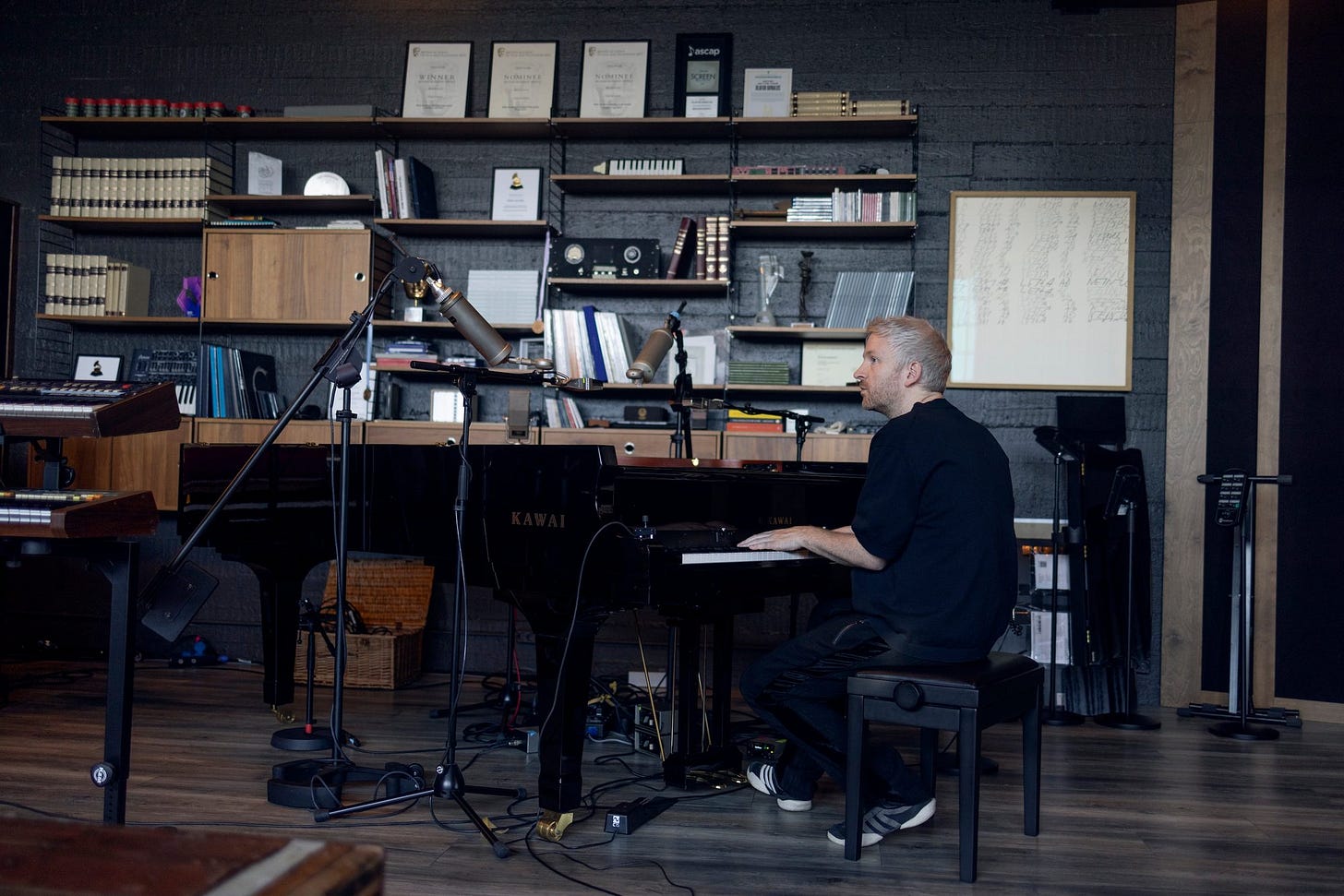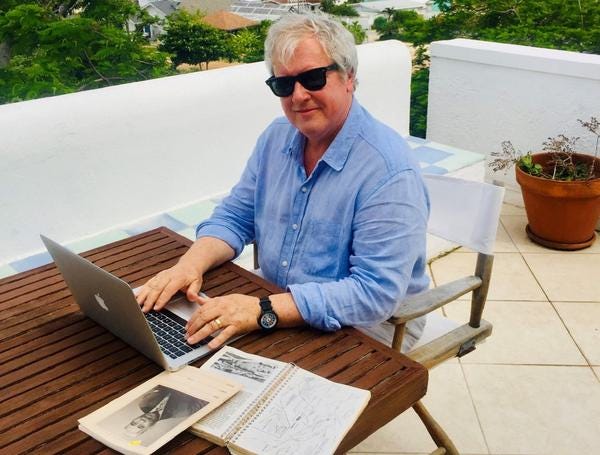A duet beyond goodbye
When Eoin French was dying, he often thought of Michelangelo’s Atlas and the concept of “non-finito” - an artwork which exists in a deliberate state of becoming. He was in the process of what he knew would be his final album with his close friend Ólafur Arnalds, A Dawning, which is out today. And this was something Ólafur Arnalds learned of only after French had gone — left with all that material and all that grief, responsible alone for liberating its final form and giving it to the world. A Dawning began as the work which brought them together, and now, it is the thing that closes the distance between here and beyond to nothing.
“I felt like I spent a lot of time with him after he passed,” says Arnalds. “Every day I worked on this record, it felt like I had this really long, soft goodbye … Before I answer anything, I ask him first. In the back of my mind, there’s a silence where I still wait for him.”
For Arnalds, who assumed the role of producer in their dynamic, making A Dawning was never about merely translating French’s writings into sound. “We were writing things together, and then we’d sculpt it until it took shape,” he says. “This reminds me, what would happen quite often while we were jamming was Eoin would take the mic and sing gibberish just to write something for a demo. You could hear a word here or there, but afterwards, he would go back to listen to the gibberish and try to figure out what he was saying.”
“I hate to compare myself to him, because I hold him in very, very high regard,” Arnalds notes, “but there are definitely parts of our personalities and our being, and the way we approach music, which are really alike. It’s hard to explain… There’s a soul in his music that is kind of unparalleled in people I’ve worked with. An emotional quality to his words, to his singing, to his style and songwriting, which I just felt very fascinated by. He’s an amazing lyric writer – and he writes fast, too, which I appreciate. We’d get into a room and things would just start flowing out of him like a waterfall. It was incredible to watch.”
A Dawning, for Arnalds, is a story in three parts, one which plays out almost chronologically throughout its sequencing. The first part tracks their initial period working together intensively, one of exploration, excitement and new connections; the second was finding a reason to fight, a reason to live and a newfound appreciation for community and brotherhood. But when French died midway through recording, Arnalds was left to complete the project on his own. The third, final part, then, is still being written. How do we live on through our community, and in our loved one’s absence, how do we protect their legacy?
“When he was passing, he gave me the permission to go through his demos and look for a piano song – because we both felt we wanted to include one of his own on the record.” Arnalds struggled to find anything, and then French’s wife reached out with something her late husband had dedicated to her on Valentine’s Day. “I instantly responded to her, ‘This is it, this is what I’ve been looking for’,” says Arnalds. “I didn’t really touch it. All I did was write the string part in the second part of the song, almost in an act of handing the song over. In a way, it’s a gesture of a love we share for her and taking the torch and carrying it from now on. It’s a strange collaboration, bouncing things back and forth through the veil.”
Out today are some major heavy-hitters, including Lightning Hit the Trees by PARADE; Justin Bieber’s surprise seventth LP SWAG; Jessica Winter’s My First Album; Gina Birch’s Trouble; Jake Minch’s George; and Clipse’s Let God Sort Em Out.
Chris Frantz of Talking Heads on Lou Reed
To his credit, Lou was one of the first well-known rock ‘n’ roll people that came down to CBGB’s and was checking the bands out. And on a regular basis. Had we not moved to New York City, we would never have met him, probably.
I was in college, at the Rhode Island School of Design when “Walk on the Wild Side” came out, and I was hip enough, or well-informed enough, to know who the various people mentioned in the song were. So I got it, I got what the song was about, and I was kind of amazed that they were playing it on pop radio!
I think the David Bowie production and involvement was a big help to Lou getting it on the radio, and what a great production it was. Just, everything about it, super cool. And it was a great departure from what we knew him for, like “White Light/White Heat” or “Heroin” or “Waiting for the Man”. It was cool and jazzy — a very sexy song — and we just loved it.
Tina and I were friends with Lou up until the end. We didn’t see him very much in the last few years of his life, he was wherever he was, and we were up here in Connecticut, out in the country. But we kept in touch by email, and I saved the ones I got from him. He became a lot sweeter as a person towards the end. He was always pretty nice to us, except when he wanted to become our producer and sign us to this really horrible production deal!
But other than that, you could even say he was supportive of what we did with both Talking Heads and Tom Tom Club. Tom Tom Club did a fifteen-night run at CBGB’s in 1988, when we did an album called Boom Boom Chi Boom Boom, which had a version of his song “Femme Fatale”, which Lou plays and sings background vocals on. So we talked Lou into coming to join us on stage on this super-hot, sweaty, jam-packed night. It was the final night of that run and it was a dream come true for Tina and me. It was the first and only time I ever actually played with him, and it was a gas. It was so much fun.
The introduction…
Meet Sea Lemon, the avant-pop project of Natalie Lew.
Hometown… Seattle, WA.
Describe your sound… Enya and The Cure had a weird little baby .
How you started making music… With limited technical skill and a lot of enthusiasm for playing open tunings.
What you want your last meal to be… Blackened salmon caesar salad with sweet potato fries.
Best synth and/or plugin… The cheapest toy Yamaha from the 80s-90s you can find.
What makes you cringe… Littering.
What makes you excited… The wild baby bunnies who made a little home in my driveway.
Sea Lemon’s debut album, Diving For A Prize, is out now.
Something Old, Something New
Every week, we share recommendations from the Best Fit community — one from the past, another from the present. This week, writer Mitch Stevens gives us his thoughts on Glassjaw’s Our Color Green (The Singles) & Coloring Book (2011) and claire rousay’s The Bloody Lady (2024).
Glassjaw, despite people’s insistence, are way more chameleonic than the post-hardcore tag that they’re consistently landed with. With every full length release, they have found a way to subvert expectations and reshape their own formula; never once sonically standing still and continuing to challenge their listeners to broaden their horizons. While not technically an LP, their 2011 EPs Our Color Green and Coloring Book, at least to me, present one of contemporary heavy music’s most feted bands at their most musically malleable.
Our Color Green encapsulates the biting fury that pulses through their catalogue; Daryl Palumbo’s lyricism drips heavier with disdain than ever, Justin Beck’s guitar work more intricate and in the pocket, the percussive segments (then played by Durijah Lang) driving each track forward with head-spinning detail. Which makes Coloring Book, released as an EP just under two months later, even more of an intriguing counterpoint. The project plays with space and groove in a way that the band had hinted at before, but never with this much conviction. Compositionally, it completely eschews any convention within the genres they exist, conventions that were inspired by Glassjaw’s own initial innovation. Melodies interweave with complex drum patterns, often taking cues from music from regions around the world. Palumbo’s vocals are almost completely clean across the six tracks, yet somehow sound simultaneously more pained and enlightened than they ever have. Due to the way both EPs were released (neither was on streaming until 2023), they’re an often overlooked chapter in Glassjaw’s catalogue, but when combined, it’s easily the most rewarding and innovative era of one of modern heavy music’s most rewarding and innovative bands.
claire rousay’s 2024 album Sentiment felt like a peculiar record for an artist’s breakout moment. A gorgeous 10 song set of atmospheric emo tracks that prefer to linger in feelings with a slow crawl of raw, fingerpicked guitar and autotuned vocals, it’s a reinterpretation of the midwest sound as you’ve never heard it before; played at the pace of someone who exists within their most intimate thoughts. It’s music to comfort you as you ruminate in your childhood bedroom, accompanied by the sound of the January rain hitting your window.
Unfathomably prolific, rousay’s next LP, The Bloody Lady, came just over six months after Sentiment. If its predecessor is the sound of sitting wistfully at your window, longing to touch a world that exists beyond it, then The Bloody Lady is those first steps into that world; filled with wonder and at times, trepidation. A reimagining of Viktor Kubal’s animated short of the same name; a story of Elizabeth Bathory, the woman who bathed in the blood of young girls to maintain her own youth. All of this context was completely lost on me when first listening to the album. As a result, I imagined my own world within the sounds, a secret garden that unfurled as I opened my door, continuing to blossom with each step. rousay’s use of texture, whether that be through field recordings or lightly droning synths really establish a world-building quality that while present in other ambient music, rarely feels as established as this. Her subtle use of melody throughout adds a glistening element to the universe being constructed before the listener, while there’s a deep undertone of menace throughout, as if one can never be certain what’s round the corner. rousay has always been a master of synthesising emotion, and while Sentiment may have seemed like her “breakout moment”, The Bloody Lady is a timely introduction to her magical tone-setting talents to those just being introduced to her genius.
Listen to the week in new music by following our Discovery playlist
Dropping at midnight every Thursday, follow our playlist for a taste of the best new music from the most exciting breaking artists. Leading the selection this week are new tracks from Hello Stranger!, CARI, Grumpy, End It, and coverstars Porcelain.
“Transposing myself into this new place, where you don’t feel that you are being in any way hemmed in by other people’s perceptions—it also allows your inner life to open back up in a new way. For better or worse, I’ve never been obsessed with other people’s perceptions of me, but I have always been obsessed with being able to do my thing.”








